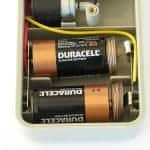I hope you had a relaxing holiday break. I know that our house has been invaded by all sorts of buzzing, flashing, and really noisy toys. And you know what all those toys have in common? Batteries.
Did you know that most devices will stop working whenever the juice in its batteries fall by just 20%?
I’m not sure I believe it but…
… I learned about a little startup that had a product called Batteriser. They make a sleeve that goes around a battery and helps you get the remaining 80%. It’s “still in development” and I’m eager to see their progress but like a lot of folks I’m skeptical (very skeptical).
(I’m very skeptical too… you know what they say about things that are too good to be true…)
Reading about it, and constantly tripping over a million flashing, singing, and rolling toys; sparked my interest in batteries.
What does a blogger do? I compiled a list of battery hacks I use to help me save money, lengthen the lifespan of our batteries, and work around incompatible battery sizes (because who wants to go to the store in the middle of the night to pick up the right battery?).
Before the hacks, we need to go through a quick lesson in batteries. Knowing how batteries work is like having a cheat code, all the hacks will make sense and you’ll be able to remember them better.
Table of Contents
- How electricity & batteries work in 60 seconds
- Not all batteries discharge equally!
- Batteries are (Kinda) Interchangeable
- How to Turn C Batteries into D Batteries
- Turn a 9Vs into 6 AAAs
- Turn a 12Vs into 8 1.5V button cell batteries
- Get More Juice by “Rubbing” Battery Contacts
- Recharge alkaline batteries with other alkaline batteries
- Remove Batteries before Storage
- Oh, don’t freeze your batteries!
How electricity & batteries work in 60 seconds
This part contains a wee bit of science and it will turn you into a MacGyver when it comes to batteries.
First, electricity is the flow of electrons through a conductor, like a copper wire.
A battery has a cathode (+) and an anode (-) separated by an electrolyte. The chemical reaction in the battery causes a build up of electrons at the anode. These electrons really want to go to the cathode to balance it out but the electrolyte stops them. They go along whatever path you supply that connects the anode and cathode, like when you put the battery in a toy. Over time, anode and cathode under go chemical change and supply no more electrons.
For alkaline batteries, this chemical change creates a little bit of hydrogen gas. That gas needs to go somewhere, which is why batteries sometimes leak. After a certain time, the pressure builds and the gas needs to escape. Batteries leak because they are being drained (phantom drain) and age. A quick takeaway here is that if you are putting anything in storage, take out the batteries.
OK, now you know about batteries. Let’s get back to electricity. It’s all about voltage and amperage (current).
If electricity were like water flowing through a hose, the amperage is the diameter of the hose. Voltage is like water pressure on the one end, or how much you’ve opened the faucet.
AAA, AA, C, and D batteries are all 1.5 volts. All the same voltage.
They differ on amperage. As a result, they contain different Watt-hours (Watts is voltage time amperage) – or total amount of energy. That explains why they’re different sizes too.
For the curious, this is a table listing all types and how much energy they contain.
Armed with this knowledge, the hacks below will make perfect sense.
Not all batteries discharge equally!
It might surprise you to learn that when your device is “out of juice,” it doesn’t mean every battery is completely consumed. Test each one to find out which one is the low man on the totem pole, then just replace him.
You’ll need a battery tester. You can get one designed to test batteries (it’s only $7) or get a multimeter (costs about $10 more) which will let you test a variety of things (current, voltage, resistance, etc.) across two points.
In most devices, you put the batteries in series to increase the voltage. It’s why you point batteries in different directions. (this is also why a 9V battery can be just 6 AAAs, which have 1.5 V each)
When your device stops working, you may only need to replace one battery. I discovered this happens a lot with children’s toys.
Replacing one battery is cheaper and easier than replacing them all. And you might have a spare lying around but not a whole set.
You can test non-rechargeable batteries without a tester — Hold them about two inches above a hard surface and drop them. A dead battery will bounce higher than a good one. Much higher. (this won’t work for rechargeable batteries)
Why does this work? Click here.
Batteries are (Kinda) Interchangeable
Want to know how Cs become Ds, AAAs become AAs?
Now that we know how many batteries we need to replace, we can start MacGyvering. Since we learned how batteries worked in the beginning, we know it just comes down to size.
How to Turn C Batteries into D Batteries

If you’re in a jam and you have a device that takes D batteries and you only have C batteries, you can jury rig the C batteries in the D’s place just by sticking in three quarters.
Put in the C battery and jam three quarters, which conduct electricity, on the negative or positive end, whichever is easiest. C batteries have less than half the energy capacity and discharge of D batteries but will work. Just not as long.
Bonus: AAA can take the place of AAs with a little crumpled up tin foil to complete the connection.
Turn a 9Vs into 6 AAAs
Cut it open and you’ll find six AAAs inside.
Here’s a video, if you are so brave:
Turn a 12Vs into 8 1.5V button cell batteries
I think you’re starting to understand how this works. 🙂
Find a A23 12V battery, cut it open, and you’ll find 8 1.5V button batteries inside. This one can save you a lot of money too because an A23 12V battery will run you about $1.00-$1.50 for a pair. A single 1.5V button battery will run you about $1.50 too. Buy two A23 12V batteries for $1.50 and rip them open to liberate $24 worth of batteries inside.
Get More Juice by “Rubbing” Battery Contacts
What happens when you rub on the contacts of a battery? You’re not “recharging” the battery a little bit, you’re just cleaning off the connection points and improving conductivity.
Remember the battery is a chemical reaction and you aren’t reversing it when you rub a contact. You are just taking off any conduction impeding gunk, so the juice can flow more easily. This might get you one last press, or two, of the remote to turn off your TV. It won’t give you another hour of shine in your flashlight. 🙂
Recharge alkaline batteries with other alkaline batteries
Apparently, you can recharge an alkaline battery using other alkaline batteries. Just tape them and wait a long time.
Infinite solutions! (I actually have no idea if this works but this guy feels confident it does and I love everything about that video)
Remove Batteries before Storage
Before you put any items in storage, where you won’t use or see them for a while, remove the batteries. Alkaline batteries will eventually leak and damage your devices, especially if left alone for many months.
We have a seemingly unlimited supply of kids toys and as they age out and lose interest, we put them away… without batteries. 🙂
Oh, don’t freeze your batteries!
I know a lot of people who store batteries in the fridge or freezer because they believe it prolongs life.
It doesn’t.
Energizer’s Non-Rechargeable Battery FAQ states:
1. Is it a good idea to store batteries in a refrigerator or freezer?
No, storage in a refrigerator or freezer is not required or recommended for batteries produced today. Cold temperature storage can in fact harm batteries if condensation results in corroded contacts or label or seal damage due to extreme temperature storage. To maximize performance and shelf life, store batteries at normal room temperatures (68°F to 78°F or 20°C to 25°C) with moderated humidity levels (35 to 65% RH).
So why do people do it? Alkaline batteries self-discharge at room temperature (70° F) at a rate of 2% per year. Storing them at lower than room temperature will help, but it’s only 2% per year and you run the risk of you forgetting you stored them next to the bag of salad you also forgot about.
NiMH and NiCd batteries (rechargeable) discharge much faster (some say a few percents a day) so there’s some logic in storing those in the fridge, but here’s why you shouldn’t. Extreme cold can cause the seals on the battery to leak. The moisture in the fridge isn’t great for the metal parts of the battery either. Finally, you should bring the battery up to room temperature before using. You might as well just charge the batteries before you need them.
Armed with this newfound power, go forth and conquer the world!




Wow Jim,
These are awesome. I had no idea there were tiny batteries inside a 9V. Also, great hack on making a C battery a D battery when you’re in a jam!
Laziness does have its uses! 🙂
That sure surprised me. Last time I tore a 9V apart, it was full of six flat cells filling out the entire innards. But that was nearly 50 years ago. Once upon a time I recall seeing commercially available small to large battery adapters too.
It’s still that way today… if it works, it works right?
Each manufacturer may use a different configuration. Not all 9V batteries have cylindrical cells inside. Also, 6 AAA batteries will not fit in a 9V battery housing. The cylindrical cells in some 9V batteries are AAAA size. (set 6 AAA batteries next to a 9V and it will be clear)
I remember ALWAYS needing batteries as a kid. As an adult, I can’t remember the last time I needed a battery (beyond the rechargables for the phone and computer of course 🙂 )
If/when you have kids… batteries will make a literal roaring comeback. 🙂
The surprise for me was the tiny screwdriver that was required for changing the batteries in everything. Changing batteries becomes an event with kids.
Ha, that’s so kids don’t eat batteries. 🙂
I didn’t know we had the option of replacing one battery in a gadget because I’ve always heard people say you shouldn’t mix new batteries with old ones. My parents used to recharge all batteries at home and it’s a pity I don’t do the same as a grown up because it can save lots of money in the long run.
One other tip here – some batteries have a small ‘charge meter’ that indicates how much power is remaining. I don’t remember which brand or type they are (maybe the rechargeable ones) but its a pretty useful feature.
I’d always heard you shouldn’t mix brands and you shouldn’t mix different types of batteries, though we’ve often mixed brands. We’ve definitely replaced just one though.
This is true and goes along with “Recharge alkaline batteries with other alkaline batteries”. It is not a good idea. When the batteries are not at the same state of charge, the fuller battery tries to charge the weaker one, which produces a gas from the reaction. This is what causes the corrosion when stored in devices for a long time. People say the batteries leaked, but that isn’t actually the case.
This is perfect timing. My daughter got a camera that needs batteries for Christmas and she has been churning through them. Will give these tips a go. Thank you!
You’re very welcome!
Interesting! I never knew these things about batteries. Batteries are something I’ve gotten as a stocking stuffer for Christmas in the past. You can never have too many batteries around these days since lots of things need them. 🙂
Batteries as stocking stuffers???? No…. 🙂
Years ago, Duracell used to give out free ‘battery testers’ as part of the packaging. Fortunately, I saved one of each type at the time. I really enjoyed the battery hacks. I even tweeted a link to your battery post. One thing that happened to me was I discovered (when my electricity went out) that all the D batteries in my 5 battery flashlight had died. Fortunately, I had a new pack of four batteries (not 5, darn). However, I put in the four new ones and one of the ‘dead’ ones, and the flashlight worked fine, almost as bright… Read more »
Thanks Fred! Yeah I remember they had these strips you could use to touch positive to negative. I have one of those cheap battery testers now and it works great. The wire inside broke once so I had to solder it but it’s so simple it was an easy fix. 🙂
Nice little jury rig on the flashlight! It’s the whole “not all batteries are discharged equally” at play for sure… saved yourself a trip (in the dark!).
This by far is the most interesting post I’ve read about batteries this week! 😉
Great info about not having to replace all the batteries! I do that way too often!
Does the brand of the battery matter? I’m assuming no, unless it’s from the Dollar Tree – those will probably explode in your remote when you’re using it. haha.
Hahahahah what about last week? 🙂 If you stick with one brand for a device, you’ll be fine. If you mean if the Dollar Tree brand is as durable as a name brand? That I don’t know but my guess is it isn’t. First, who knows how long it’s been on a shelf before it goes to clearance places like dollar stores. Next, you don’t know if it’s made of quality materials so it might leak faster? I’d worry more about age though. When you buy a new TV, the batteries they give you are no-name brands so they don’t… Read more »
Remember to tape the terminals on your batteries before recycling or tossing them and always store them in their cardboard boxes. Several houses have burned from loose 9v batteries in the junk drawer.
Really? Burned because of loose 9v batteries?
My crack research staff (I googled it) uncovered this story on Snopes – http://www.snopes.com/horrors/techno/9voltfires.asp – “partly true”… which is more true than I expected!
Touch a 9v battery to steel wool and you can see the potential for kindling a fire… it’s essentially little wires with more resistance than they can handle. Up in flames.
It’s a credible hazard, but has an exceptionally rare occurrence. The combination of very specific circumstances and conditions required are extremely unlikely to occur, even in a kitchen “junk drawer”. There are much, much greater fire hazards in the average home. By far, the most common cause of house fires is an unattended kitchen stove top, one that has been accidentally left on (gas or electric), and deep frying cooking oil/grease fires. The second most common are electric heaters: baseboard that are blocked or covered, wall heaters , and especially portable “space” heaters (electric, kerosene and catalytic). Careless smoking remains… Read more »
Wow I am skeptical too, but that is news to me 9v batteries can cause a fire. Lucky for me that has never happened.
I am not sure I believe batteries might stop working after 20% loss, but I guess anything is possible. Great read.
Most smoke detectors use, you’ve guessed it, 9v batteries, wouldn’t it be truly ironic if these started a fire. btw I’ve just ripped open an AA and got covered in nasty gunk, presumably caustic, which I carefully washed off right away. There were no cell batteries inside so I’m guessing cheaper production methods have made the above hack redundant. Instead I’ve taped a couple of dead L22’s to 2 AA’s which I reckon will charge them enough to use in my multimeter til the shops open tomorrow. If not I will let you know.
PS. the batteries must be connected in a loop otherwise it won’t work
I ive got a power bank that came with my tent I bought for camping. It uses 4 D batteries to power some built in LED strip lights through a usb connection, im sure that it gets.very weak to the point of not chsrging in about an hour maybe puts a charge of 40% on the phone at that point if im using it while charging even st minimum brightness or battery usage from my phone settings it will begin to die faster than its charging.
You might want to remove the “How to recharge batteries” video from your blog. While it is entertaining (I laughed many times!), it is not based on any facts of physics. Refer back to your explanation of how batteries work. The electrons need to flow from one place to another. Putting two positive ends together will not cause any electrons to flow. This could work if you also connected the negative terminals together. This puts the cells in parallel, essentially creating one larger battery of the same voltage. In this configuration, the voltage will equalize between the cells to some… Read more »